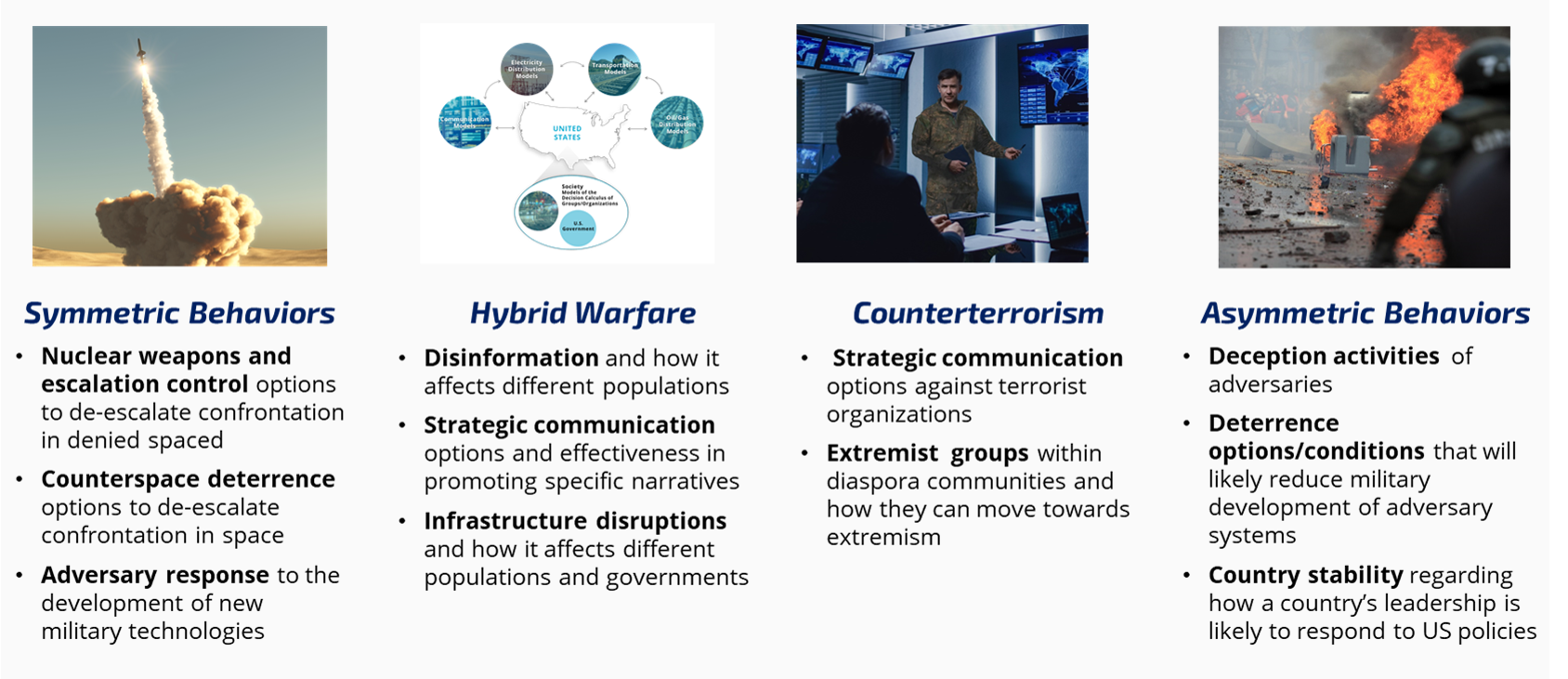
Typical DYMATICA Assessments
DYMATICA models have assessed different geopolitical and socio-cultural narratives pertaining to the internal perceptions of a country’s status, capabilities, and hegemony over other countries. This involves the modeling of PMESII-PT factors associated with a country’s economic and military capabilities, as well as their self-perceptions, behavioral tendencies, and internal political dynamics.
DYMATICA assessments typically need to consider current and projected economic situations, social and political dynamics, and narratives that are active within the country of interest (COI). Furthermore, global economic, military, and geopolitical circumstances could also have an impact on the stability within this COI. For example, if a more powerful non-NATO neighboring country started to actively use hybrid forms of aggression directed towards a less powerful NATO country, it could have large-scale impacts on the internal social, political, economic stability of that NATO country as well as other NATO countries.
This type of relationship is visually described in the figure below which, for example, could be addressing question, “How do changes in economic circumstances, military capabilities, geopolitical positioning, and sociopolitical conditions affect a country’s stability and ability to project power over the next ten years?” In this scenario the dynamics within the country can be assessed such as the interactions and influences between political parties, the political leader, as well as other countries that are interacting with the COI. Here, the dynamic interactions between modeled countries and institutions/organizations and within a COI would be affected by multiple, co-occurring exogenous variables.

A typical DYMATICA assessment assess how different scenarios and courses of action (COA) are likely to affect key outcomes (subject to a variety of causal hypotheses) over time (see figure below as an example). Depending on the situations of interest, these outcomes may be geopolitical (such as gamesmanship between different COI), at the group level (such as targeted propaganda exploiting the political leanings of various groups, or tendencies of groups to engage in conflict or social unrest or to support U.S. actions), and individual level (such as decisions made by leaders).

Typical DYMATICA Assessment Outputs
DYMATICA assessments are tailored to fit the information needs of the customer. A DYMATICA assessment might include a fairly large number (30+) number of parameters, such as country GDP which can change over time. These changes can be reflected in the model as parameter updates.
An analyst can use DYMATICA to better understand various geopolitical and sociocultural landscapes if one or more conditions change. To accomplish this, analysts can use the model to adjust parameters to play out various “what if” scenarios. Modifiable parameters can be such things as changes in GDP, levels of military strength in specific areas, degree of aggressiveness in foreign policy, amounts and types of migration, and the like. As one or more of these parameters are adjusted, the results will dynamically change to reflect the scenario change.
For example, the two figures below show two examples of a small number of parameters that can be adjusted. The first and second examples show more common DYMATICA assessments.

Example 3 shows the anticipated likelihood of conflict over time. Here the figure is divided into a reduced chance of having some specific conflict and a greater chance of having a specific conflict. Lines on the more extreme bottom or top denote a greater or less chance of conflict. Individual behavioral paths can be examined, as well as any change from a reduced chance to a greater chance of conflict and vice versa. Better understanding the conditions that reduce the chance of conflict can help provide additional tools necessary to increase the probability of peace.

Example 4 shows anticipated changes in the level of societal support for a violent extremist group versus (core) and a faction of that group (faction) that split off in 2018. The base case is the anticipated strength of support by the local society before any specific actions or policies are taken. To assess the effects of certain specific actions and policies a user would adjust one or more parameter. This would affect the anticipated strength level of societal support for both the core and faction groups over time.

Analytics Scenario Example: Population Reaction to Violent Extremism
Question of Interest: Assessment to address the question; how would changes in specific government policies and support, along with changes in demographics and wealth distribution affect the relationship between high, medium, and low socioeconomic status population groups and a violent extremist group (VEG)?
Approach: Since the focus is on the reaction of different populations in response to changes in governmental and societal conditions and how this will alter their relationship with a VEG over time, models of would be developed that represent different populations and the VEG. This would include representing the perceptions, motivations, and behaviors of high, medium, and low socioeconomic status (SES) populations along with a VEG, including any factions. Elements such as social demographics and changes in wealth distribution would serve to help define the SES populations over time. Other factors, such as climatic changes, civil wars, and ecological disruptions could also be included if relevant. Currently available data would be used to automatically update the model every 24 hours. This would include governmental and world organization statistical data, polling data, and social medial data.
Example Result Description: The results would assess how different government policies, conditions and societal changes affect the populations’ relationship with a VEG over time. A user would be able to assess current conditions and assess potential, future behavioral relationships under different conditions. This would assist in the planning of future policies and actions on the part of a government or world organization.
For more information
- Bernard, M. L. (2020). Using Computational Geopolitical/Sociocultural Modelling to Assess Response Options to Information-Related Hybrid Threats. Senior Leadership Roundtable on Military and Defense Aspects of Border Security in South East Europe.
- Naugle, A.B., & Bernard, M.L. (2017). Using computational modeling to examine shifts towards extremist behaviors in European diaspora communities. In Advances in Cross-Cultural Decision Making (pp. 321-332). Springer, Cham.
- Passell, H. D., Aamir, M. S., Bernard, M. L., Beyeler, W. E., Fellner, K. M., Hayden, N. K., … & Silver, E. (2016). Integrated human futures modeling in Egypt (No. SAND-2016-0388). Sandia National Lab. (SNL-NM), Albuquerque, NM (United States).
DYMATICA™ Tabletop Exercise Simulations
DYMATICA has been coupled to detailed infrastructure network models and a social media model to simulate disruptions within a victim country’s infrastructure and to represent social interactions pertaining to the disruptions. This capability is being applied to hybrid warfare assessment and training systems (see scenario example).
In the example figure below, three DYMATICA models are coupled with different types of infrastructure models and an agent-based model. Here, the DYMATICA models represent a vulnerable society, including its major institutions and populations (i.e., a victim actor), a country that is supportive to the victim country including its major institutions and populations, as well as an aggressor country.
This addresses how disruptions in such things as electrical power (including Internet communications), foodstuff, petroleum/natural gas, and commuter/ freight rail services affect various populations. Here, a semi-fictitious city was developed to meet specific training tasks and to keep the scenario at a non-sensitive level. Modeled adversary behaviors are based on actual, but non-attributed behaviors of populations.

Within the simulated vulnerable society, DYMATICA represents decision making of governmental, banking and media institutions. It also represents high, medium, and low socio-economic status populations (SES; represented as groups A, B and C in the Figure). This can also include minority groups and their relationships with other minority groups, as well as the majority group and the institutions within that society. Also included in the form of adjustable parameters, are economic conditions, military capabilities, and general resources of the modeled country.
Modeling the decision calculus of each entity comprises of capturing and representing key decision elements pertinent to those entities and the scenario. These are derived from reports and data with respect to a modeled entity’s perceptions, motivations, norms, and behavioral intentions associated with the scenario. This information is structured in a manner that characterizes both the shorter-term (six hours) and longer-term (such as one or more years) decision processes of institutions and populations. For example, in examining populations, short-term behaviors would be most relevant in responding to infrastructure disruptions. However, governmental institutions would need to respond to both short-term and longer-term disruptions, which would necessitate longer-term goals and policies to remedy the disruptions.
Tabletop Exercise Scenario Example: Simulation of Populations
Task: Tabletop simulations for training agencies to better understand and anticipate how certain actions and conditions will differently affect various populations and institutions, and groups.
Approach: Run detailed and realistic scenarios that enable users to improve their performance by training on events that have either already occurred or could realistically occur. This would include simulations of different population groups, government institutions, non-governmental organizations along with simulations from infrastructure network models such as electrical power, water, communications, and transportation networks. Here, simulated populations would have physical location and would be affected by local conditions, such as a power or traffic disruption. Communications between different populations would also be simulated, which would include such things as social media and traditional news. The spread of information or perceptions about events would also be represented. The specific city, region, or country that is simulated would be determined by the client. The simulation would be configurable to enable multiple runs of the same conditions, the probabilistic occurrence of conditions, or direct manipulation of conditions by a user.
Example Result Description: Simulation outputs would include likely behaviors over time for each population group. A user would be able to interrogate the simulation to assess how a combination of different disruptions, policies and actions would produce counterproductive behaviors.
For more information
- Kelic, A., Beyeler, W. E., Mitchell, R., Bernard, M. L., Doyle, C. L., Rogers, A. N., … & Klise, K. A. (2020). The Grey Zone Test Range Integrated Urban Simulation Environment (No. SAND2020-4198). Sandia National Lab. (SNL-NM), Albuquerque, NM (United States).
- Bernard, M. L. (2020). Using Computational Geopolitical/Sociocultural Modelling to Assess Response Options to Information-Related Hybrid Threats. Senior Leadership Roundtable on Military and Defense Aspects of Border Security in Southeast Europe.
DYMATICA™ Operational & Command Authority-Level Decision Making
DYMATICA is being extended to simulate decision making during all phases of conflict. Here, well-grounded psychological and behavioral-economic theories and calculations are being used to provide simulated decision making within command authorities down to the tasking of the groups of platforms. Each simulated decision is a function of psychological characteristics along with capability/resource, environmental, and group dynamic factors.
Computationally, the DYMATICA engine consists of a modeling framework and model simulators. The structure allows for model simulation across different domains. This consist of a 1) system representation of dynamic interactions between entities; 2) cognitive model components, which represent the decision process of cognitive entities; and 3) world model components, which include all non-cognitive elements in the simulation (such as adversary positioning, behaviors, and resources). A simplified representation of the DYMATICA decision process is shown in the figure below, which represent the decision making of each simulated command authority.
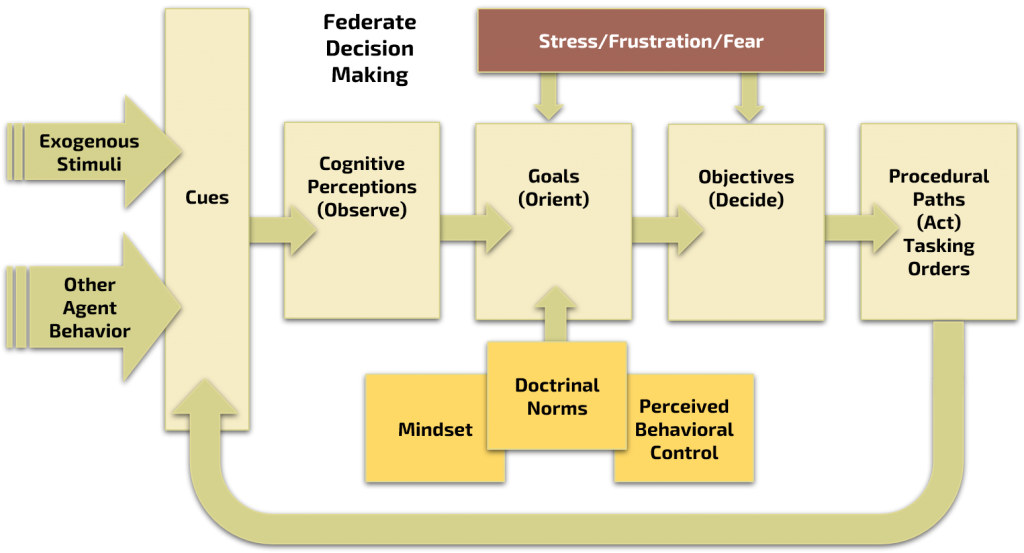
Operational & Command Scenario Example: Assessment of Factors Affecting Decision Making
Question of Interest: Assessment to address the question; how would a combination of different conflict conditions, application of techniques, tactics, & procedures (TTP)s, and levels of team cohesion affect team decision-making performance?
Approach: Since the focus is on assessing team decision performance, separate models of operator types would be developed (as an example, a pilot, a radar operator, and a navigator exemplar would act as separate model agents that would interact which each other). A wide variety of potential conditions (via cues) could be selected to affect individual team member models. This would affect their perceptions, goals, and objectives, which would affect the overall performance of the team. These perceptions, goals, and objectives would be based on previous performance measures and subject matter expert guidance.
Example Result Description: The results would assess how different conditions and the application of one or more TTP and different levels of cohesion affect team performance over time.
For more information
Additional information available upon request.
Fact Sheet
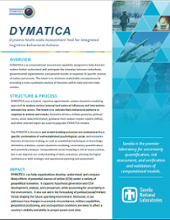
Click Fact Sheet to download PDF.
Brochure
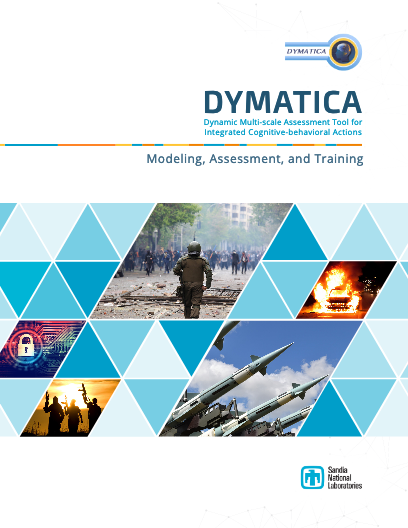
Click Brochure to download PDF.
Presentation
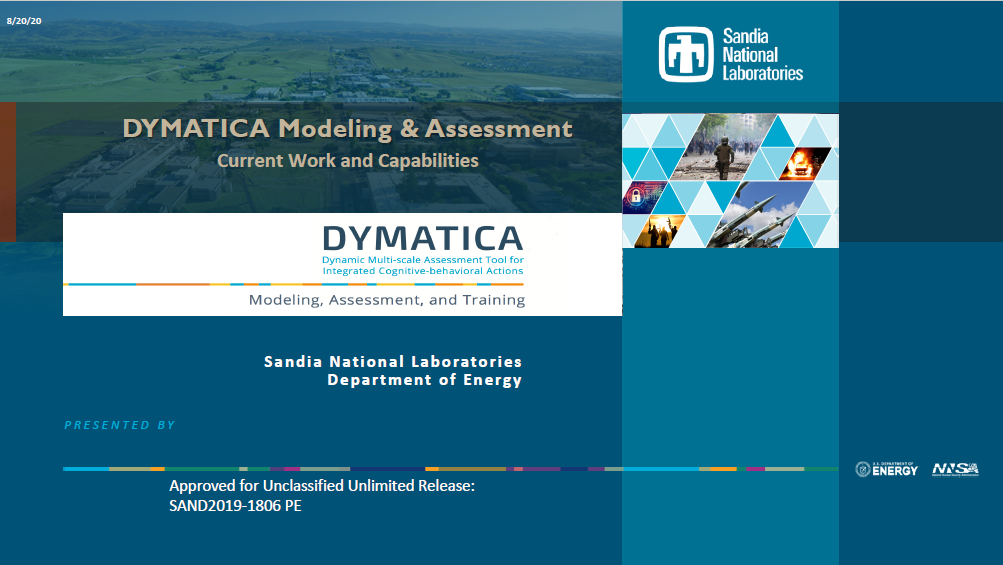
Click Presentation to download PDF.